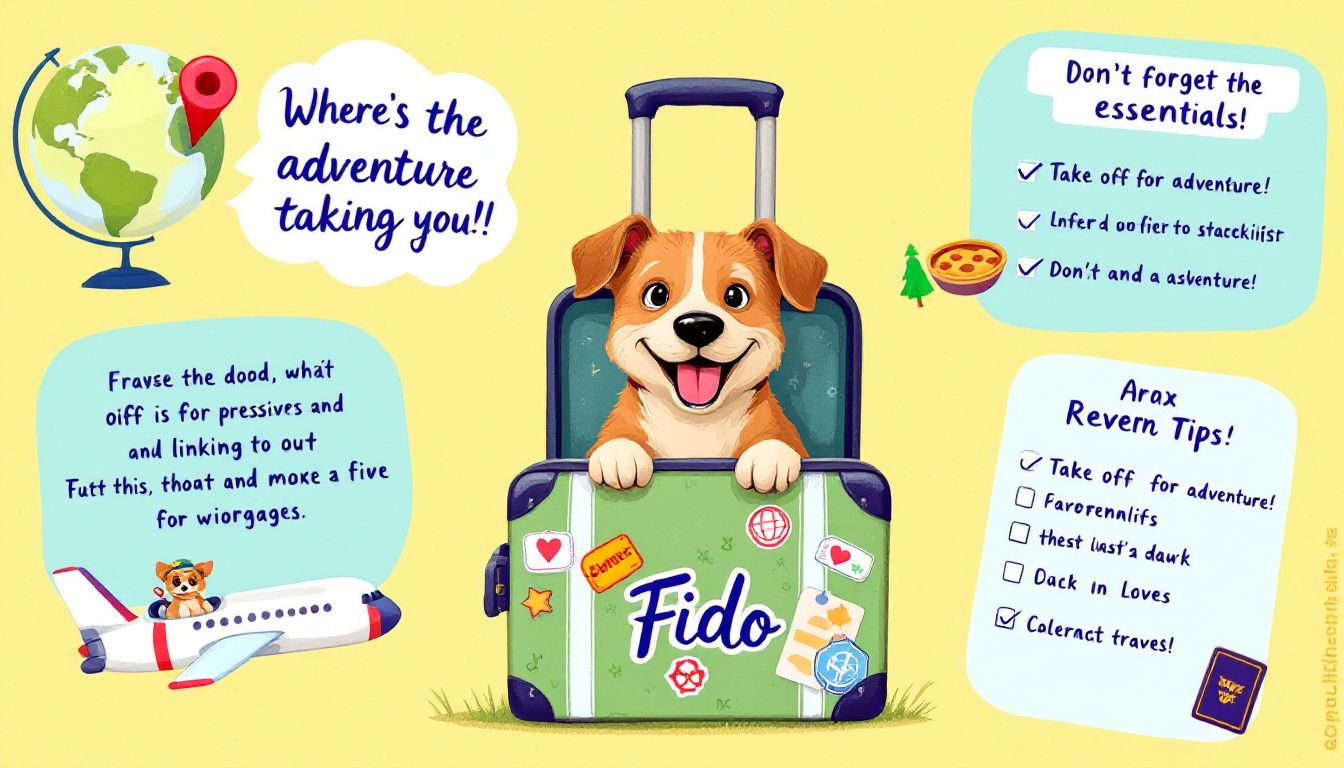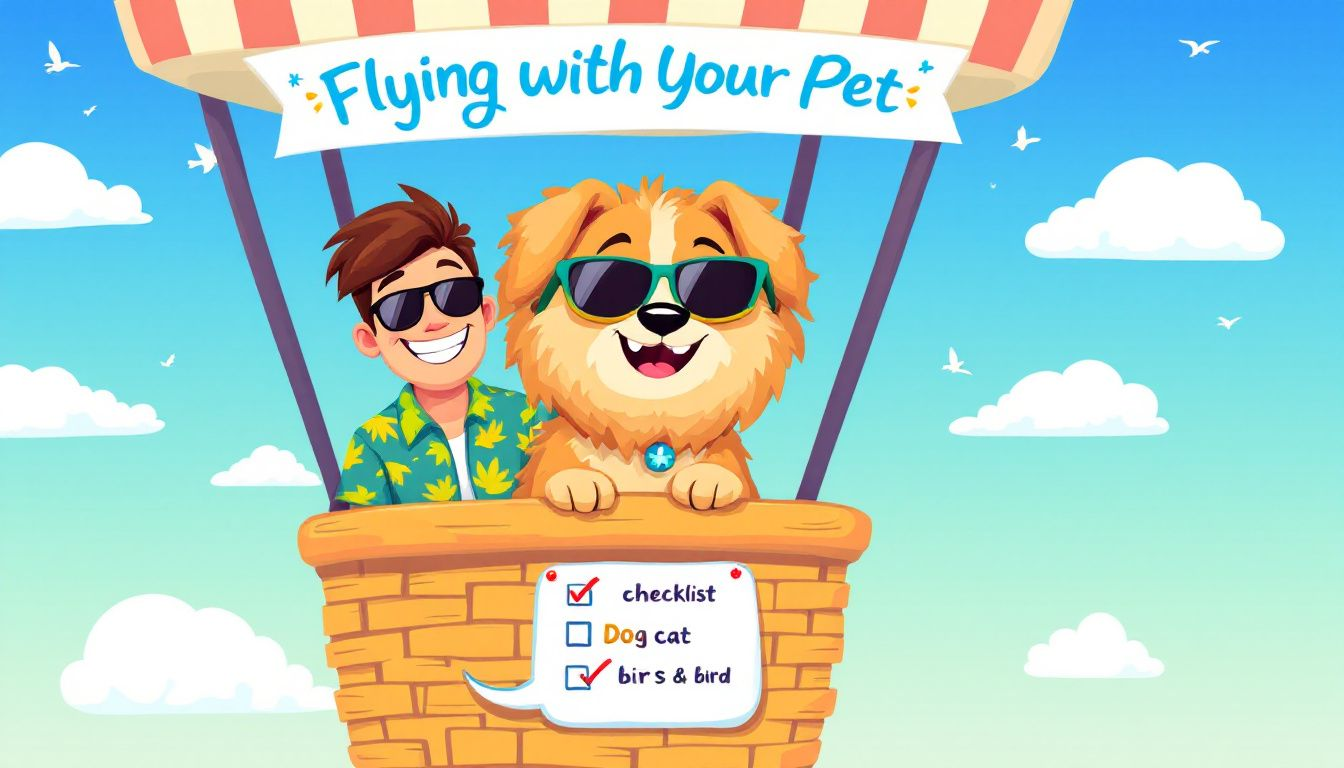Traveling with your pet for the holidays? Here are essential tips for holiday travel with your pet to ensure a smooth and safe journey. Learn how to prepare, keep your pet comfortable, and make your trip stress-free.
Key Takeaways
-
Proper preparation, including a vet check-up and familiarizing your pet with travel carriers, is essential for a stress-free holiday journey.
-
Ensure pet safety during travel by using secure carriers or harnesses, scheduling regular breaks, and managing motion sickness.
-
Research and book pet-friendly accommodations in advance, and bring familiar items to help reduce your pet’s travel anxiety.
Preparing Your Pet for Travel

For a smooth and stress-free holiday travel experience with your pet, preparation is key. Pet parents should start by keeping their pet’s routine as normal as possible, which helps acclimatize them to travel conditions and reduces anxiety. Observe your pet’s eating, drinking, and potty habits during travel to detect any unusual behaviors early and address them promptly.
Scheduling a vet visit is an early step in travel preparation. This ensures vaccinations are up to date and allows discussion of any health concerns with the veterinarian. Your vet can also offer advice tailored to your pet’s specific needs and travel destinations.
Introduce your pet to their travel carrier well before the trip. Use toys and treats to make the carrier a familiar and comfortable space.
Lastly, packing an essentials bag with food, treats, collapsible bowls, medications, medical papers, ID tags, a portable water bottle, an extra leash, and poop bags is crucial for ensuring your pet’s comfort and safety during travel.
Vet Check-Up and Vaccinations
A pre-trip vet check-up confirms your pet is fit to travel and ensures their pet’s vaccinations and health records are up to date. If you are crossing state lines or traveling internationally, obtaining a signed health certificate from a veterinarian is required. Access to vaccination records and IDs is necessary for quick verification during travel.
Carry a current photo of your pet. It’s incredibly helpful for quick identification if your pet gets lost.
Familiarize with Travel Carrier
Introduce your pet to their travel carrier ahead of time. Place it in a familiar environment and encourage exploration with toys and treats. This helps your pet associate the carrier with positive experiences, making it less intimidating.
A dog crate is essential for car travel safety. Ensure it’s spacious enough for your pet to stand, turn, and lie down comfortably. For air travel, select a carrier that meets airline specifications and allows your pet’s crate to travel safely.
Pack Essentials
A well-stocked essentials bag is crucial for your pet’s comfort and safety. Include food, treats, a collapsible bowl, medications, medical papers, ID tags, a portable water bottle, an extra leash, and poop bags. These items prepare you for any situation during your trip.
Carry extra food and medications to cover unexpected delays or emergencies. A supply of waste bags is also important to maintain cleanliness during stops.
Being well-prepared with all the necessary items will help keep your pet comfortable and secure throughout the journey.
Road Trips with Your Pet

Road trips can be a fun and exciting way to travel with your pet, but they require careful planning for a successful road trip. Ease your pet’s anxiety by gradually introducing them to travel conditions. Start with short car rides and slowly increase the duration.
Ensure your pet’s safety in the car by securing them with seat belt harnesses, crash-tested crates, or carriers. Plan regular potty breaks for your pet’s comfort and well-being. Stop three to five times a day for adult dogs to relieve themselves and stretch their legs.
Managing motion sickness is crucial for road trips with pets. Consult your veterinarian for effective strategies. Feeding your pet on an almost empty stomach before travel can help reduce motion sickness.
Secure Your Pet in the Car
Keeping your pet safe in the car is a top priority. Use seat belt harnesses, crash-tested crates, or carriers for secure travel. A seat belt harness keeps your dog safe in the back seat. Ensure it fits securely but allows movement; two fingers should fit underneath.
For cats, secure them in a cage or carrier strapped down with a seatbelt to ensure safety throughout the journey.
Plan for Regular Potty Breaks
Regular breaks allow pets to relieve themselves and stretch their legs. Schedule potty breaks for adult dogs three to five times a day to ensure comfort and well-being. Before stopping the car, check your pet’s ID tag and secure their leash to prevent accidents.
Factors like age, weight, medication, breed size, and health conditions influence how often dogs need potty breaks. Plan ahead to accommodate these and ensure your pet’s age and comfort.
Motion Sickness Management
Motion sickness can be challenging. Consult your veterinarian for effective management. Feeding your pet on an almost empty stomach before travel can reduce the risk of motion sickness.
Flying with Your Pet

Flying with your pet requires careful planning and preparation for pet air travel. Here are some tips to consider:
-
Choose the right flight to minimize stress for both you and your pet.
-
Opt for the most direct route to reduce travel time and potential stressors.
-
Arrange reservations in advance.
-
Understand the airline’s pet policies.
By following these guidelines, you can ensure a smoother travel experience for you and your furry friend.
Decide between in-cabin and cargo hold travel. Whenever possible, opt for in-cabin travel to minimize stress and ensure comfort. If cargo hold travel is necessary, use an airline-approved crate that meets safety specifications.
Prepare for security screening by having your pet on a harness and leash at the checkpoint to keep them secure. Arrive early at the airport to ensure a smooth check-in process and address any documentation requirements.
Choose the Right Flight
Selecting the right flight is key to a stress-free travel experience. Choose the most direct flight to minimize travel time and stress. When flying with pets, arrange reservations in advance and understand the airline’s pet policies.
Before flying with your pet, check the airline’s pet travel policy and carrier size requirements. Arrive early to ensure smooth check-in and fulfill documentation requirements.
In-Cabin vs. Cargo Hold
Whenever possible, travel with your pet in the cabin to minimize stress and ensure comfort. Pets flying in the cargo hold must be in an airline-approved crate for safety.
If cargo hold travel is necessary, ensure the crate is labeled ‘Live Animal’ with your contact information for safety.
Prepare for Security Screening
Prepare for security screening by having your pet on a harness and leash at the checkpoint to keep them secure. This helps ensure a smooth and safe process for both you and your pet.
Accommodation and Pet-Friendly Options

Finding pet-friendly accommodations is crucial. Many hotels now embrace pet-friendly policies, with over 75% of various hotel classes accommodating pets. Inquire about any restrictions or specific requirements for pets when booking accommodations.
Research pet-friendly hotels in advance and book early, especially during peak travel seasons. Bringing familiar items from home can help your pet adjust more quickly and reduce stress.
Compile a list of nearby veterinary clinics before traveling to ensure quick access in case of medical emergencies. This preparation can save time and reduce stress during emergencies while traveling.
Research Pet-Friendly Hotels
Some hotels offer amenities like pet beds, treats, and walking areas. Check for nearby green spaces when selecting a hotel, as not all pet-friendly hotels provide easy access to outdoor areas.
Many hotels offer pet-friendly rooms. Research is essential to find the right one. Book in advance to ensure availability, particularly during peak travel seasons.
Bring Familiar Items
Bringing familiar items helps your dog adjust more quickly to new surroundings and reduces stress. Familiar scents and favorite toys can significantly alleviate travel anxiety for your pet.
Local Vet Contacts
Before traveling, it’s wise to compile a list of nearby veterinary clinics to ensure quick access in case of medical emergencies. This preparation can save time and reduce stress during emergencies while traveling.
Managing Cold Weather Travel

Holiday travel often involves cold weather during the holiday season. Ensure your pet stays warm with appropriate gear designed for winter conditions. High-performance boots protect dogs’ paws from extreme cold and rough surfaces.
Keep an eye on temperature changes to keep your pet safe. Monitor temperature changes when traveling with pets in winter to ensure their safety.
Proper Gear for Cold Weather
Recommended cold weather gear for pets includes insulated jackets, reflective material, non-slip booties, and paw balm. Equip your pet with appropriate cold weather gear to shield them from harsh elements.
Monitor Temperatures
Monitor temperature changes when traveling with pets in winter to ensure their safety. It becomes dangerous for dogs to be outdoors at 20°F and below.
Alternatives to Traveling with Your Pet
If traveling with your pet is not feasible, consider local pet care services to ensure their well-being. Hiring a pet sitter or opting for a reputable boarding facility are excellent options.
Dogtopia provides a comfortable and fun environment for pets when pet owners cannot travel with them.
Researching and selecting reliable care options for your pets can ease your mind and ensure their happiness during travel.
Hiring a Pet Sitter
Hire a trusted pet sitter to care for your pet at home, ensuring they remain in a familiar environment. Look for pet sitters with positive reviews and a solid reputation to ensure your pet’s well-being. Interview potential pet sitters to assess their experience and compatibility with your pet’s needs.
A pet sitter can provide the comfort of home and help maintain your pet’s routine, minimizing stress during your absence. This option is beneficial for pets that may not adapt well to new environments or have specific needs best met at home.
Boarding Facilities
Choosing a reputable boarding facility involves visiting and asking questions about their care practices. Dogtopia maintains activity levels for pets with fun activities and offers personalized updates during their stay. Many boarding facilities offer engaging activities and regular updates on pets’ activities to reassure owners.
Owners can monitor their pets at Dogtopia through webcams and livestreams.
Summary
Traveling with your pet during the holiday season can be a joyful experience with the right preparation. Ensuring your pet’s vaccinations are up to date, familiarizing them with their travel carrier, and packing essential items are crucial steps for a safe trip. Whether you’re embarking on a road trip or taking a flight, securing your pet and planning for regular breaks will make the journey more comfortable for both of you.
If traveling with your pet is not possible, hiring a pet sitter or using reputable boarding facilities can provide peace of mind. By considering these options and preparing thoroughly, you can ensure that your pet remains safe, comfortable, and happy during your holiday travels.
Frequently Asked Questions
What should I pack for my pet when traveling?
To ensure your pet's comfort and safety while traveling, pack essentials like food, collapsible bowls, medications, medical papers, ID tags, a portable water bottle, and an extra leash. Don't forget poop bags to maintain cleanliness on your journey.
How can I manage my pet’s motion sickness during travel?
Consulting your veterinarian is essential for effectively managing your pet’s motion sickness. Additionally, feeding your pet on an almost empty stomach before travel can help mitigate the issue.
What should I look for when choosing a pet-friendly hotel?
When choosing a pet-friendly hotel, prioritize researching specific pet policies, weight limits, and any additional fees, while also considering the proximity to green spaces for your pet’s enjoyment. This will ensure a comfortable stay for both you and your furry companion.
How can I ensure my pet's safety during air travel?
To ensure your pet's safety during air travel, opt for the most direct flight, use an airline-approved carrier, and have your pet secured on a harness and leash for security screening. Taking these precautions can make the journey smoother for both you and your pet.
What are some alternatives if I can't travel with my pet?
If you can't travel with your pet, hiring a trusted pet sitter or using a reputable boarding facility like Dogtopia can ensure your pet is well cared for. These options provide engaging activities and regular updates, giving you peace of mind while you’re away.


